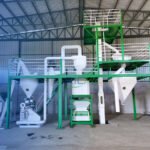Thailand, with its thriving agricultural sector and rich natural resources, offers a wide array of biomass raw materials suitable for pellet production. As the country moves towards more sustainable energy solutions, the potential for biomass pellet production line has gained significant attention. This article explores the various biomass raw materials available in Thailand that can be utilized in a Biomass Pellet Production Line.
Agricultural Residues
- Rice Husks and Straw
Thailand is one of the world’s largest rice producers, generating substantial amounts of rice husks and straw as byproducts. These materials are excellent for pellet production due to their abundance and consistent supply throughout the year. Rice husks have a high silica content, which can produce pellets with good durability. - Sugarcane Bagasse
As a major sugarcane producer, Thailand has a significant supply of sugarcane bagasse, the fibrous residue left after extracting juice from sugarcane. Bagasse pellets have a high calorific value and low ash content, making them ideal for both industrial and residential use. - Cassava Stems
Thailand is the world’s second-largest exporter of cassava products. The stems left after harvesting cassava roots can be processed into pellets. Cassava stem pellets have shown good combustion properties and can be an excellent way to utilize this agricultural waste. - Corn Stalks and Cobs
With a substantial corn industry, Thailand produces a considerable amount of corn stalks and cobs as residues. These materials can be effectively pelletized, offering a solution for agricultural waste management while producing a valuable energy product.
Forestry and Wood Processing Residues
- Sawdust and Wood Shavings
Thailand’s furniture and wood processing industries generate significant amounts of sawdust and wood shavings. These fine wood particles are ideal for pellet production, requiring minimal pre-processing. - Forest Residues
Sustainable forest management practices in Thailand yield various residues such as branches, tops, and low-quality wood that can be used for pellet production. This helps in efficient utilization of forest resources while providing a renewable energy source. - Rubber Wood Residues
Thailand is the world’s largest rubber producer. When rubber trees are no longer productive for latex, they are typically harvested for wood. The residues from this process, including sawdust and offcuts, are excellent raw materials for pellet production.
Energy Crops
- Napier Grass
Napier grass, also known as elephant grass, is a fast-growing perennial grass that has gained attention as an energy crop in Thailand. It has high biomass yield and can be harvested multiple times a year, making it an attractive option for dedicated biomass pellet production. - Giant King Grass
Similar to Napier grass, Giant King Grass is being cultivated in Thailand specifically for biomass production. Its rapid growth rate and high yield make it an excellent choice for sustainable pellet production. - Bamboo
Thailand has abundant bamboo resources, which can be used for pellet production. Bamboo grows quickly and has a high calorific value, making it a promising biomass feedstock.
Palm Oil Industry Residues
- Empty Fruit Bunches (EFB)
Thailand’s palm oil industry generates significant amounts of EFB, which can be processed into pellets. While EFB pellets may have higher ash content compared to wood pellets, they offer a valuable way to utilize this abundant waste product. - Palm Kernel Shells
Another byproduct of the palm oil industry, palm kernel shells can be pelletized to create a high-density fuel. These pellets typically have a high calorific value and low moisture content.
Considerations for Raw Material Selection
When choosing raw materials for a Biomass Pellet Production Line in Thailand, several factors should be considered:
- Availability and Supply Chain
Ensure a consistent and reliable supply of the chosen raw material. This may involve establishing partnerships with agricultural cooperatives or industrial suppliers. - Moisture Content
Different biomass materials have varying moisture contents. Materials with high moisture content may require additional drying, impacting production costs. - Ash Content
The ash content of the raw material affects the quality of the final pellet product. Lower ash content is generally preferred, especially for residential and premium industrial applications. - Calorific Value
The energy content of the raw material influences the pellet’s heating value. Materials with higher calorific values are often more desirable. - Pelletizing Properties
Some materials pelletize more easily than others. Factors such as lignin content and fiber structure can affect the pelletizing process and the quality of the final product. - Seasonal Availability
Consider the seasonal nature of some agricultural residues and plan for alternative raw materials during off-seasons to ensure year-round production. - Transportation and Logistics
The proximity of raw material sources to the production facility can significantly impact costs and overall efficiency.
Conclusion
Thailand offers a diverse range of biomass raw materials suitable for pellet production, reflecting its rich agricultural and forestry sectors. From rice husks and sugarcane bagasse to rubber wood residues and energy crops, the options are plentiful and varied. This abundance of raw materials positions Thailand favorably in the growing biomass pellet market.
The key to successful biomass pellet production line in Thailand lies in strategically selecting and combining these raw materials to ensure a consistent supply, maintain product quality, and optimize production costs. By leveraging its natural resources and agricultural byproducts, Thailand can establish a robust and sustainable biomass pellet industry.
As the global demand for renewable energy continues to grow, Thailand’s biomass pellet sector has the potential to not only meet domestic energy needs but also become a significant player in the international market. The effective utilization of these diverse biomass resources through pellet production can contribute significantly to Thailand’s renewable energy goals, rural development, and overall economic growth.


